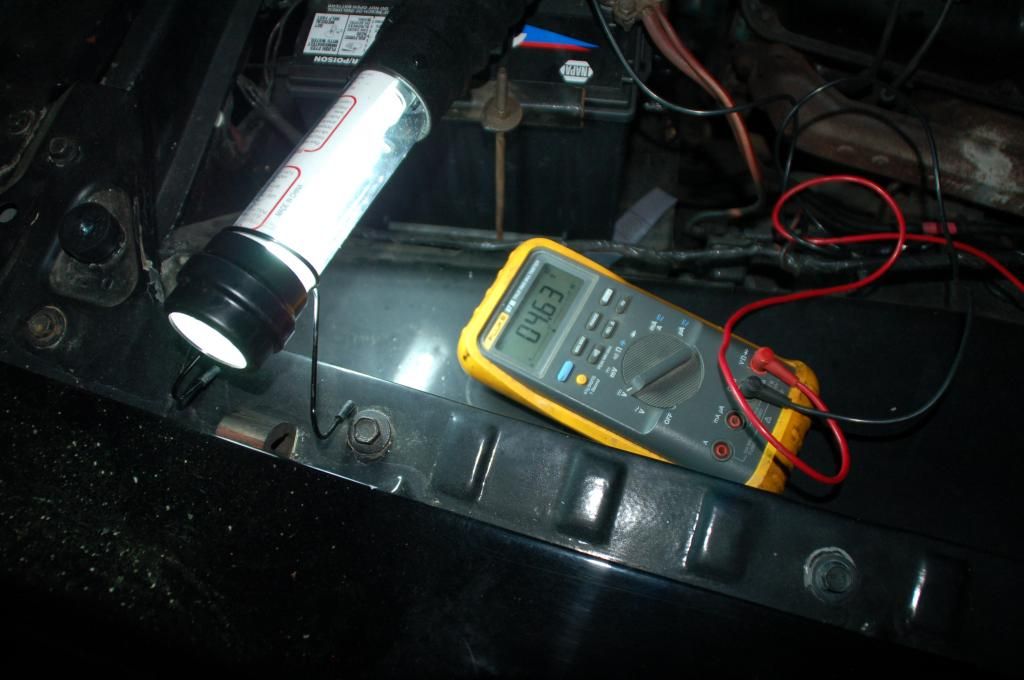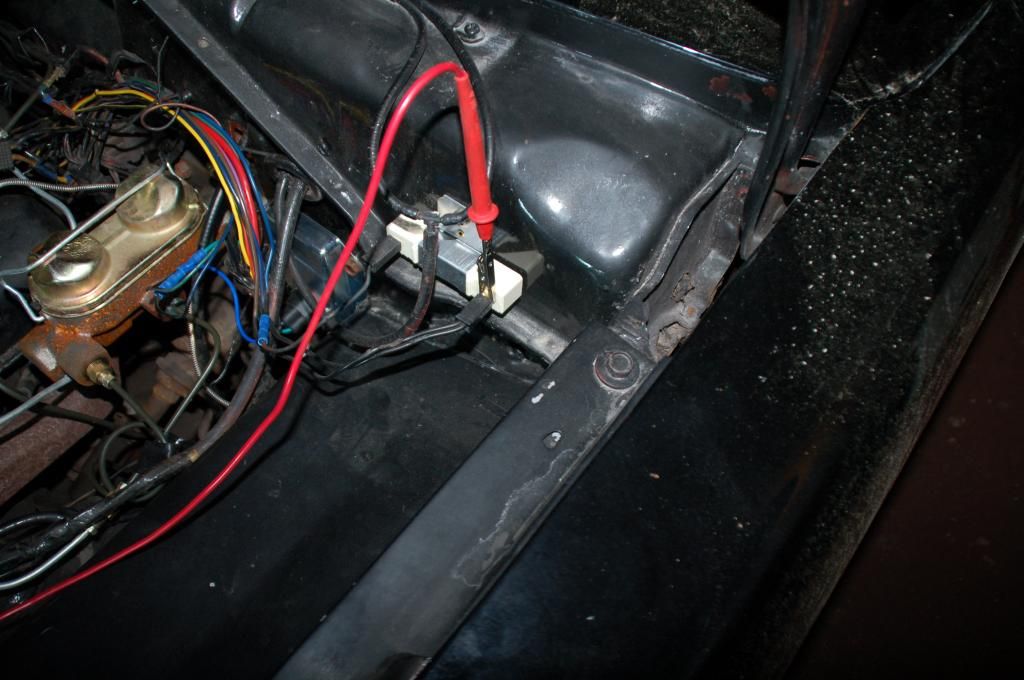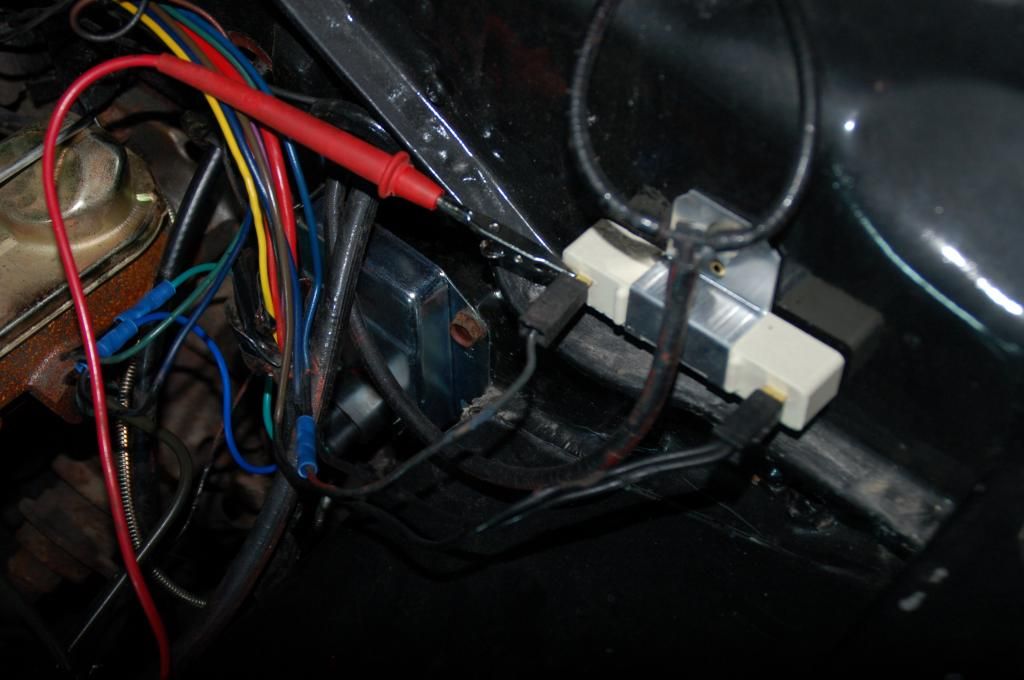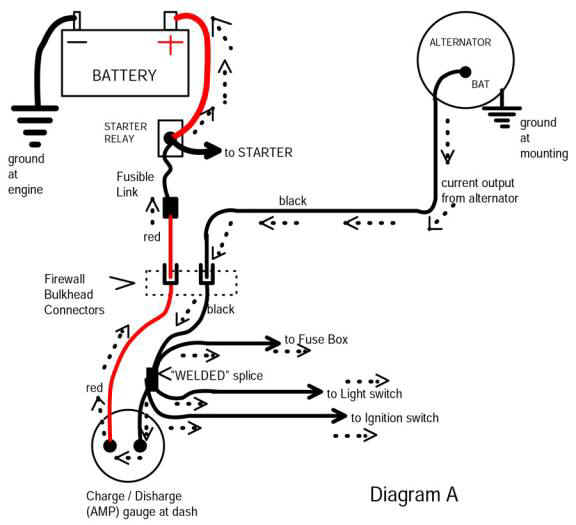That is LOW LOW LOW!!!!!!!!!!!!!!!!!!
Compare that 9.34 to battery voltage
That is, what IS battery voltage? If the battery is dead, ????
In other words the "high side" of the ballast should be within 2-3 tenths of one volt as "same as battery."
Here is your current path
Read this, but mostly look at the diagram:
http://www.madelectrical.com/electricaltech/amp-gauges.shtml
The simplified diagram from the above page:
Follow along. Start at the battery, to the stud on the starter relay, follow the FUSIBLE LINK along the RED wire through the bulkhead connector.
From there we go to the ammeter, through the ammeter, and out on the BLACK ammeter wire. Notice that we come to the "welded splice." See where it says "to ignition switch?"
What is NOT shown is now we continue on from the splice, to the IGNITION SWITCH CONNECTOR, the switch, through it, BACK OUT the switch connector (on the ignition run line, or IGN1, dark blue) and BACK OUT through the bulkhead connector
Now that we are back through the bulkhead connector, we feed any underhood loads, in your case, the ballast resistor and the voltage regulator.
WHY IS THIS ONLY 9 VOLTS?
Because, somewhere in the above circuit path, you have a BAD CONNECTION
The bulkhead connector terminals are probably the no1 cause
About next on the list is the ignition switch connector, or the switch itself.
Next might be troubles at the ammeter, the connections, or inside the ammeter itself.
Last, rare, but this HAS happened, is sometimes, the welded splice has failed.
You need to backtrack, LEARN to test for voltage drop, and FIND the trouble.
??HOW?? do you find this??
You learn to read diagrams. Download a factory manual. It's "just like" a road map. You have a GREAT multimeter, hell, it might be better than my old Flukes, which are more than 15 years old
FIRST!!!! You MUST have the circuit under test UNDER LOAD to find voltage drop. This is especially important if you have a breaker points system, because when the points are open, with engine not running, but with key "on" there is only the alternator field through the regulator.
HOW?? to simulate a load??
One way is to pick the "high" side of the ballast, and hook a load to it for testing.
SO!!! find yourself something like an old headlight that still works, "rig" some (heavy) clip leads to the lamp, and hook it to the same place as your VR IGN terminal.
Now you can unhook the ballast and "not" burn up the coil, ballast, or points as you test
So with your load (lamp) hooked up, and key "in run" you can start to look for the trouble.
THINK in your mind, "the circuit path." Just like a road map.
FIND the wire where "ignition run" (dark blue) comes through the bulkhead. PROBE that and compare the voltage to the BATTERY voltage
WIGGLE the wire terminal in the bulkhead. V goes up? Changes? good indication you might have found part of the problem
Go inside the car. Probe the same terminal from INSIDE the car. Is the voltage higher than the last test?
You are on the right track.
"Jump" to the IGN switch. Pull it out, hang it down, so you can get to it. Probe the battery (big black) wire and compare that reading to "right at the battery" Is the voltage close to the same? Much lower?
That would indicate a problem in the RED wire coming through the bulkhead, or the ammeter.
Now compare voltage at the big BLACK going into the IGN switch, and the "dark blue" ignition run.
Are these voltages different? How much? "Wiggle" the switch connector. Any change?
Wiggle the key in the switch........any change?
This is exactly like driving down a highway, you go here, you stop for gas, you go further, you fix a flat tire, and so on. You change highways. You turn off onto this little road. Follow the map






















